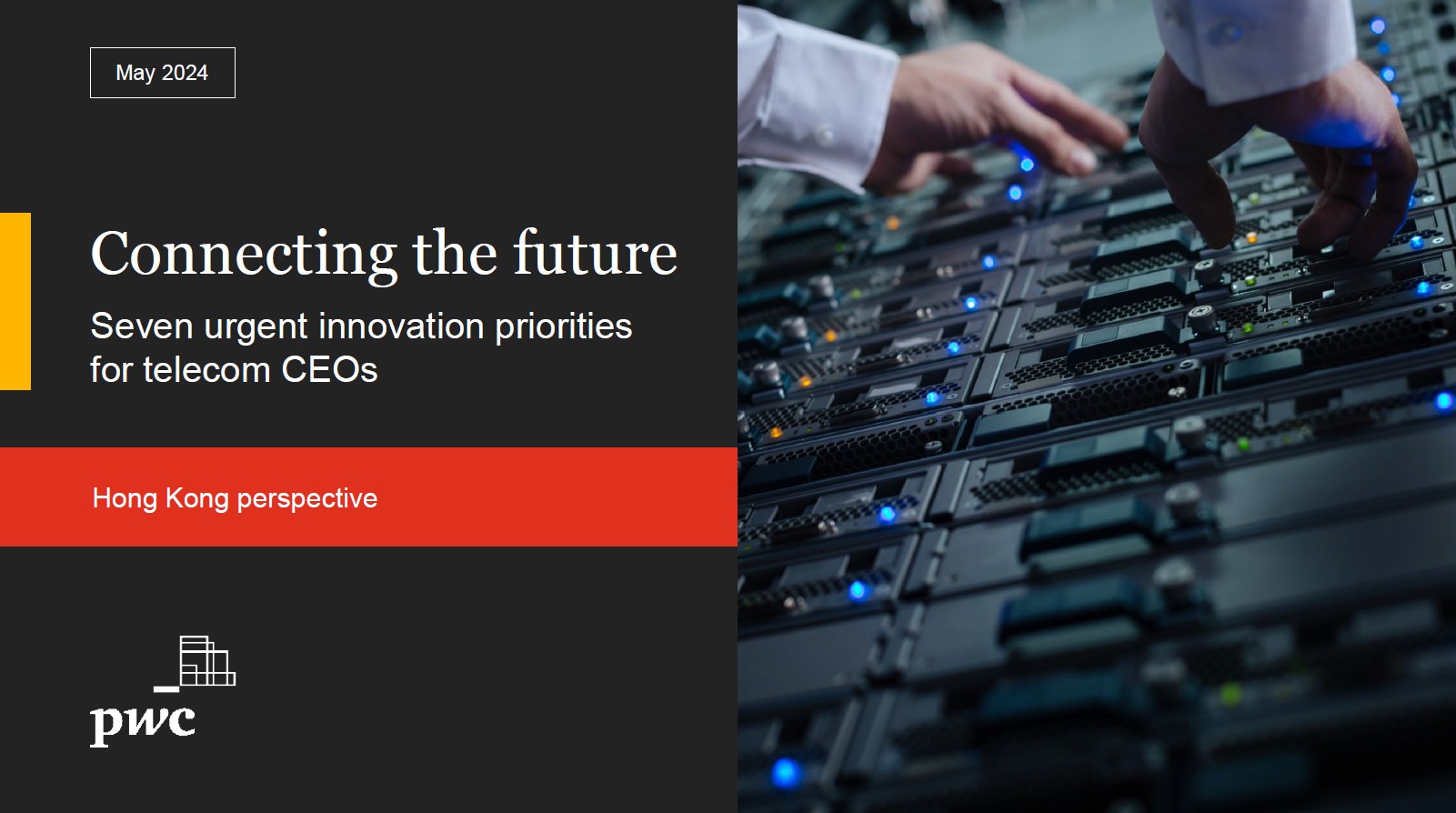Download the report
Until a few years ago, the definition of a telecom company was straightforward: a communications services provider with a business model that combined and integrated a wide variety of components, including network infrastructure and operations, proposition development, and sales and service aimed at B2C or B2B customer segments.
What telecom companies will look like in the future is less clear. The fundamental shifts in revenues and value pools identified in PwC’s inaugural Global Telecom Outlook and its report Perspectives from the Global Telecom Outlook 2023–2027 are forging a new ecosystem, posing threats, and creating new opportunities. As leaders face the coincident challenges of industry reconfiguration and company reinvention, we’ve identified seven urgent priorities for telecom CEOs in Hong Kong. Together, these priorities make up a comprehensive road map to higher value, competitiveness and growth.
Priority 1: Reinventing the telecom business model
To ensure the continuation of telecoms’ value-creating potential, leaders need to fundamentally rethink the utility of a vertically integrated carrier model, with a core focus on examining, optimising and potentially separating the distinct business layers or diversifying their business into other industry segments, such as FinTech and HealthTech, and exploring more strategic business opportunities across different technology platforms and geographical locations. Leaders also need to expand the product offerings to address the varying needs of different target audiences with the power and implication of 5G network.
Priority 2: Strengthening competitive fortitude and commercial innovation
Customer experience is the fundamental and necessary condition for pricing power. Companies have to rethink the entire customer experience: the network, the device, sales and service, and the potential to provide value-added products and services. Although providing both mobile and fixed broadband is already common, the addition of fixed wireless access is gaining traction and should add momentum to converged customer relationships. And the more that service relationships are established across devices, lines, subscriptions and household members, the lower the propensity is for churn.
Priority 3: Embracing the cloud
Many telecom companies are well on their way to “cloudifying” their IT services and internal enterprise processes. Although the first wave of cloud-native players in Hong Kong have yet to fully prove and scale their case, the technical, operational, and economic benefits of cloud-centric operations are undeniable.
Priority 4: Building the GenAI-driven carrier
AI technology—and especially the emerging class of generative AI (GenAI) tools and capabilities—has tremendous potential in all aspects of a telecom company’s business. Operating in AI-enabled ways will become the industry norm in areas including network management, device interfaces, and customer and employee experience. Those players who move early to lead this transformation stand to gain a significant competitive edge.
Priority 5: Orchestrating workforce renewal
There is a cyclical surge to build fibre networks. The continued worldwide 5G network deployments—and the 6G networks that will follow—require telecom engineers and tech talent, and are also driving demand for construction and civil workers. But there are labour supply shortages in many of these markets. Telecom companies need to launch initiatives to attract and retain highly skilled and innovative talent (e.g. forming partnerships with educational institutions and governmental bodies, implementing talent development programmes, etc.).
Priority 6: Building resilience to risk and quickly responding to regulatory changes
As telecom companies increasingly seek growth through geographical expansion and diversification into non-core industries, they will engage with unfamiliar regulatory frameworks outside the telecommunication space. And, as we’ve noted, the rise of AI and GenAI is imposing a sense of urgency for leaders to ensure responsible use of these new technologies. These circumstances compel leaders to engage proactively with policy-makers in order to help shape regulatory frameworks and ensure compliance.
Priority 7: Building the sustainable carrier
Sustainability is now a crucial element for companies to operate effectively. Recently, transparent reporting on ESG (environmental, social, and governance) performance has shifted from a mere goal to a necessary requirement for regulatory compliance, societal expectations, and maintaining reputation.
In March 2024, the Hong Kong Government’s Financial Services and the Treasury Bureau published a statement setting out the vision and approach of the Government and financial regulators towards developing a comprehensive ecosystem for sustainability disclosure in Hong Kong. In particular, the Government will work with financial regulators and stakeholders to develop a roadmap on the appropriate adoption of the International Sustainability Standards Board’s (ISSB) Standards, and the Hong Kong Institute of Certified Public Accountants (HKICPA) will assume the role of the sustainability reporting standard setter in Hong Kong to develop local sustainability reporting standards aligned with the ISSB Standards.
In April 2024, the Stock Exchange of Hong Kong (The Exchange) published conclusions to its consultation on the enhancement of climate-related disclosures under its ESG framework. The Exchange noted broad-based market support for this enhancement but agreed to modify its proposals to reflect IFRS S2 more closely. The new climate requirements will be phased in from 2025. The Exchange has also published implementation guidance that includes references to the relevant principles in IFRS S1 to assist issuers’ compliance with the new climate requirements.
While the regulatory environment continues to evolve, the overall direction is established and irreversible. The call for achieving net-zero emissions is clear and has garnered public commitments from most telecom operators. However, the specific path to achieve net zero remains less certain.
Conclusion: The age of reconfiguration
As is evident, the agenda of telecom CEOs is remarkably full. It is filled with both complex challenges and compelling opportunities. Taking them on and embracing them is the work not just of a single leader, but of the full senior leadership team. And, as our colleagues note, the industry is not alone in facing the reconfiguration imperative.
But what’s needed is not just far-reaching strategies and flawless execution. Rather, an important shift in mindset is required. Leaders need to be both radically audacious and incredibly practical: radically audacious in questioning previous assumptions and established products, and in scaling solutions at high speed. And they need to be incredibly practical in developing realistic plans and overcoming the powerful forces of inertia. The future is on the line.

Contact us

Global Technology, Media and Telecommunications Industry Leader and China Artificial Intelligence Leader, PwC China
Tel: +[86] (755) 8261 8886

Contact us









